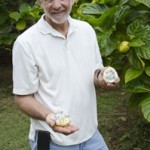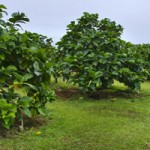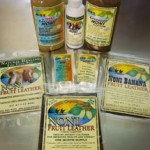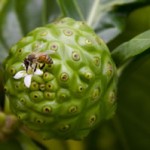Noni, Polynesian Miracle Fruit
Hawaiian Health Ohana Farm is a certified organic farm that has been growing thousands of noni trees on 20 acres since 1981. The sustainable property generates 75 percent of its energy through windmills and solar panels. Water for food processing comes from a well, owner Steve Frailey makes and uses compost, fertilizes with foliar spray, and uses no-till soil methods to preserve biological activity in the soil.
Frailey produces unfermented, raw fruit leather and lotion made from 100 percent pure noni pulp and juice. A low-heat drying process below 115 degrees preserves medicinal properties.
“The powerful phytonutrients, brain and pain-relieving chemicals and enzymes in it remain highly biologically active,” says Frailey in a Doctors’ Prescription for Healthy Living article.
NONI
Noni has been used as a principal medicine in Polynesian culture for 2,000 years. Traditionally, noni was taken for coughs, colds, pain, liver disease, malaria, hypertension and intestinal worms. Topically, it was used for sprains, swelling, bruises and wounds.
“They’ve identified six different varieties of noni,” says Frailey. “In Hawaii, we only have one variety, and it’s the medicinal variety.
It was a canoe plant – they’re not going to bring a junk one across the ocean – so they brought the one that they valued the most.”
Today, scientific studies confirm what our Polynesian predecessors knew. Research proves that noni is loaded with 165 compounds that have healing properties for a multitude of ailments.
Instead of eating the fruit, most people ferment noni in large glass jugs and drink the juice.
“Fermentation changes the chemical profile,” says Frailey. “It destroys all the digestive enzymes and 50 percent of the compounds.”
International Journal of Food Sciences and Nutrition published an industry-wide mineral profile of 177 competing brands of commercial noni juice. The study found that the concentration in most commercial brands is of minor nutritional significance.
“If fermentation is allowed, then a different chemical profile is almost certainly present,” says Dr. Brian Issell of the University of Hawaii. In a study for improving the quality of life in his cancer patients, Issell used unfermented noni.
Season: If grown in full sun, noni will fruit year-round. “They’re extremely hardy,” says Frailey. “All they need is mulch, good air flow and water.” Seeds take three to four months to germinate, two years to grow into an 8-foot tree, and five years to produce good fruit.
What to look for: When ripe, the fruit is soft and translucent like a tomato.
Storage: Once ripe, noni will last two to three days in the refrigerator.
Preparation: Traditionally, noni has been eaten like an apple. This is tricky for most people, because the taste and smell is compared to blue cheese and stinky feet. Noni is not consumed for pleasure, it is consumed strictly for its healing properties.
Health benefits: Noni has been proven to be effective in decreasing joint destruction and pain caused by arthritis; has a hypotensive effect that lowers blood pressure; is beneficial to diabetics because it lowers cholesterol, triglycerides and blood sugar; reduces oxidative stress in diabetes; contains anti-inflammatory, antibacterial, anti-fungal activities; is 75 percent as strong as morphine; has anti-depressive and anti-anxiety properties and promotes a sense of well being, and has no side effects.
Testimonials from users of Hawaiian Health Ohana’s products say it healed Lyme disease, ulcers, irritable bowel syndrome, periodontal disease, and cuts and bruises.
It also improved digestion, reduced blood sugar, provided pain relief from arthritis, rejuvenated skin (wrinkles, acne, eczema, psoriasis, ulcers, sunburn), and eased fibromyalgia symptoms.
Former University of Hawaii sports trainer Melody Toth used IcyHeat Lavender Noni Lotion on her athletes for tired legs, bone spurs, arthritis, repetitive trauma, ankle support, low back pain, and quadricep and hamstring injuries.
Hawaiian Health Ohana products can be found at: Farm tours are available, and an invitation is extended to grade-school teachers. Visit Real-Noni.com to order online, or for store locations.
Call toll-free: 1-888-882-NONI.
HEALING NONI DRINK
The juice of fermented noni has beneficial compounds, just not as many. If you have access to noni, Steve shares his recipe for making an unfermented drink.
* 1 white noni Wash a hard, white noni and set it on the counter. In two to three days, it will become soft and clear. Put it in a blender at slow speed to masticate it, or squish it with your hands into a strainer over a bowl. Remove seeds, and keep skin, pulp and juice. “Most people only keep the juice,” says Failey, “but there are compounds in the skin and pulp so you’re throwing away benefits.
“It’ll come out like a thick apple sauce,” says Frailey. “You can puree it, add water to make it thinner, or add cinnamon or lemon juice, to take the (blue cheese) flavor away.” Drink 1 ounce daily. Refrigerated, it will stay unfermented for two to three weeks.
“You can also use it as a topical, but you’ll stink. That’s the advantage of using the lotions.”
- Steve Frailey, Hawaiian Health Ohana. Daniel Lane photos
- Hawaiian Health Ohana is a sustainable noni farm
- A variety of noni products are available
- Each noni eye sprouts a flower. Daniel Lane photos







